Kenneth C. Davis's Blog, page 50
July 2, 2018
Whatever Became of 56 Signers? (11 of 11)
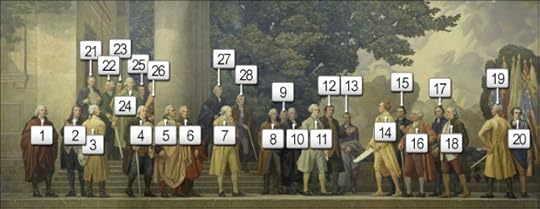
The Declaration Mural by Barry Faukner (National Archives)
Last part of a series on the lives of the 56 men who signed the Declaration of Independence, adopted by the Second Continental Congress on July 4, 1776. (A YES following the entry means the signer enslaved people; a NO means he did not.)
…We mutually pledge to each other our Lives, our Fortunes , and our Sacred Honor.
A New England slaver. A forgotten founder who died in debt and disgrace. A college president. A legendary bullet maker. Jefferson’s teacher –and a murder victim. Last but not least among the 56 signers.
–William Whipple (New Hampshire) Usually described as a 46 year old merchant, he was more precisely a sea captain who made a fortune sailing between Africa and the West Indies — in other words, the slave trade. He also enslaved people and one of those men, known as Prince, accompanied Whipple throughout his illustrious career as an officer in the Revolution. It was thought that Prince was the black man depicted in the famous “Washington Crossing the Delaware” painting, but that is not accurate because Prince and Whipple were far from the action that night. Whipple later served in a variety of state offices in New Hampshire and legally manumitted Prince –who also went by the name of Caleb Quotum — in 1784. Whipple died in Portsmouth in 1785. YES
–William Williams (Connecticut) A 45 year old merchant, he was a veteran of the French and Indian War who had married the daughter of Connecticut’s Royal Governor. He was not present for the July vote but signed the Declaration and was a tireless supporter of the war effort. After a long career in public service, he died in 1811, aged 71. NO
–James Wilson (Pennsylvania) Scottish born, he was a 33 year old lawyer at the time of the signing and one of the most important Founding Fathers you probably never heard of. A key supporter of the Declaration, Wilson was among the signers and Philadelphia elites who were attacked in his home during the war in a riot over food prices and scarcity. Wilson was also a key member of the Constitutional Convention, credited with several significant compromises. Although hopeful to be made Chief Justice of the new Supreme Court, he was appointed an associate by Washington. But land speculation ruined him and he ended up in debtor’s prison, like his colleague Robert Morris (See previous post #7) before his death in disgrace at age 55 in 1798, an embarrassment to his Federalists friends and colleagues. NO
–John Witherspoon (New Jersey) Another profoundly influential immigrant, the Scottish born minister was 53 year old president of the College of New Jersey (later Princeton) where his hatred of the British influenced many students including notable schoolmates Aaron Burr and James Madison. He lost a son at the battle of Germantown in 1777 but continued his career in Congress. After the war, he attempted to rebuild the college and was a prime mover in the growth and organization of the Presbyterian Church. He died in 1794 in Princeton, where the is buried, at age 71. YES
–Oliver Wolcott (Connecticut) A 49 year old lawyer, he was a veteran of the French and Indian War who was not present for the vote and signed at a later date. Wolcott was in New York when Washington’s troops tore down a statue of King George III after hearing the Declaration of Independence read. He is credited with the plan to melt down the lead statue and turn it into bullets for the war effort. He served in the Connecticut militia during the Revolution and held a series of state posts after the war including as governor of Connecticut at his death in 1797 , aged 71. YES
–George Wythe (Virginia) A 50 year old lawyer, he made his greatest mark as a teacher of law to Thomas Jefferson at the College of William and Mary –as well as later students including James Monroe, future Chief Justice John Marshall and congressman Henry Clay, earning him the title “America’s first law professor.” He died in 1806 , around 80, apparently murdered by a nephew who was perturbed that Wythe was planning to free the slaves that the young man was supposed to inherit. (The nephew was acquitted of murder but convicted of forging his uncle’s checks). YES
Read the story of James Wilson and the Philadelphia Riot in America’s Hidden History.
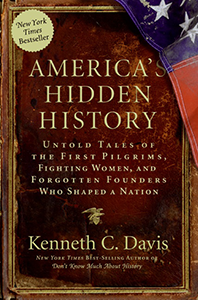
America’s Hidden History, includes tales of “Forgotten Founders”
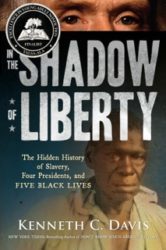
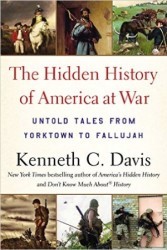
Now In paperback THE HIDDEN HISTORY OF AMERICA AT WAR: Untold Tales from Yorktown to Fallujah
June 30, 2018
Whatever Became of 56 Signers (Part 10 of 11)
(Part 10 of a series that begins here. A YES at the end of the entry means the signer enslaved people; NO means he did not.)
…We mutually pledge to each other our Lives, our Fortunes , and our Sacred Honor.
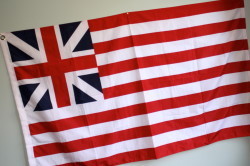
The Grand Flag of the Union, first raised in 1775 and by George Washington in early 1776 in Boston. The Stars and Stripes did not become the “American flag” until June 14, 1777. (Author photo © Kenneth C. Davis)
A victim of the British. Two Irish immigrants. An orphaned carpenter. Among the next five of 56 signers.
–Richard Stockton (New Jersey) Of the signers who clearly suffered for his actions, this successful and widely-admired 45 year old attorney at the signing, may have suffered most. Stockton is also credited with recruiting John Witherspoon, an influential Sottish minister, (See next installment in series) to become president of the College of New Jersey (later Princeton). Betrayed by loyalists in his home state, he was captured by the British in 1776, although later released in a prisoner exchange, not for having sworn allegiance to the King, as reported in a much-disputed rumor of the day. His New Jersey home was also damaged by the British but later restored. Stockton was in poor health after the experience in captivity but lived until 1781, when he died of throat cancer. YES
–Thomas Stone (Maryland) Among the conservatives in Congress, he was a 33 year old attorney at the signing, reluctant about independence, but then joining in the favorable vote. Another son of a wealthy planter, he had a low profile after the signing, helping write the Articles of Confederation but not signing them. He also declined to take part in the Constitutional Convention, when his wife, who fell ill following an inoculation against smallpox, died in 1787. Apparently despondent, he died four months later in 1787 at age 44. YES
–George Taylor (Pennsylvania) Arriving in America as an indentured servant from Ireland, he was a 60 year old merchant and iron maker at the signing. He had risen at the foundry where he worked to become bookkeeper, then bought the business after his employer’s death and then married the late owner’s widow. Taylor was not in the influential Pennsylvania delegation for the July vote, but signed the document in August. During the war, his foundry provided cannon and cannonballs for the war effort, but Congress was notoriously slow to pay its bills and his business suffered. He died in 1781 at age 65. YES
–Matthew Thornton (New Hampshire) An Irish-born physician, he was around 62 at the signing, a veteran surgeon who had served with the New Hampshire militia in the French and Indian War. A latecomer to Congress, he joined in November 1776 and was later permitted to add his name to the document. He later served as a state judge and then operated a farm and ferry before his death in 1803 at about age 89. NO
–George Walton (Georgia) Orphaned and apprenticed as a carpenter, he was a 35 year old self taught attorney at the signing. Although his exact birth date is unknown, some claim that he was the youngest Signer – a distinction usually given to Edward Rutledge (See previous entry). Serving with the Georgia militia, he was shot and captured by the British in 1778. Well-treated, he was held for a year before being exchanged for a British officer –even though it was known he was a signer. He later served in a variety of state offices, including governor and senator from Georgia, and built a home on lands confiscated after the war from a Tory, or Loyalist. He is implicated in the events that led to the duel that killed fellow signer and political rival Button Gwinnet (see Part 3 of series). He died in 1804, aged 63 (?) . Yes/No [? Unable to confirm his status as a slaveholder pending further investigation.]
. Yes/No [? Unable to confirm his status as a slaveholder pending further investigation.]
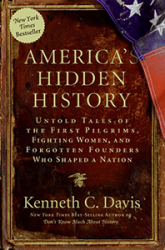
America’s Hidden History, includes tales of “Forgotten Founders”
June 29, 2018
Whatever Became of 56 Signers? (Part 9)
(Part 9 in a series that begins here; a YES following the entry means the signer enslaved people; NO means he did not.)
…We mutually pledge to each other our Lives, our Fortunes , and our Sacred Honor.

The Grand Flag of the Union, first raised in 1775 and by George Washington in early 1776 in Boston. The Stars and Stripes did not become the “American flag” until June 14, 1777. (Author photo © Kenneth C. Davis)
Betsy Ross’s uncle. The “first psychiatrist.” Youngest signer. The Great Compromiser. An Irish man named Smith. The next five signers:
–George Ross (Pennsylvania) The son of a Scottish-born minister, he was a 46 year old attorney at the signing, a loyalist before turning to the patriot cause in 1775. Yes, he was Betsy’s uncle, but the rest of the Ross flag story has been dismissed as family legend. He left Congress in early 1777 due to illness — the same severe gout that afflicted a number of signers– and served as a Pennsylvania judge before his death in 1779 at 49, following a severe attack of gout. NO
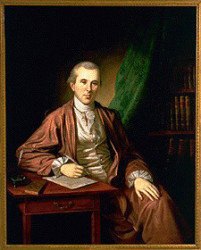
Dr Benjamin Rush by Charles Willson Peale c. 1783. Winterthur Museum
–Benjamin Rush (Pennsylvania) Raised by a widowed mother, he was a 30 year old physician at the signing, youngest in the Pennsylvania delegation. He was elected after the July vote and his diaries, letters, and notes provided some of the best portraits of many of the signers and other founders. He served as surgeon general of the armies during the war, and became an early abolitionist while still a slaveholder himself. Rush was also an early advocate of many modern medical practices, while at the same time practicing bloodletting. He established the first free medical clinic and remained in Philadelphia during a yellow fever epidemic, spoke against capital punishment, and in favor of the idea that there was mental illness which led to his being called “The Father of American Psychiatry.” He died of typhus in 1813 at age 67. YES
–Edward Rutledge (South Carolina) Son of an Irish immigrant physician, he was a 26 year old attorney at the signing, the youngest of the signers. Rutledge later left Congress and was captured by the British when Charleston fell in May 1780 and was held for nearly a year. After the war, his finances and businesses flourished and he returned to state politics, and was elected governor of South Carolina, but died at 50 in 1800, before his term ended. YES
–Roger Sherman (Connecticut) A self-educated son of a farmer, he was a prosperous merchant, attorney, and politician, aged 55 at the signing. He would sign three of the central documents in America’s foundation: the Declaration (he was a member of the draft committee), the Articles of Confederation, and the U.S. Constitution. It was at the 1787 convention that Sherman proposed the “Great Compromise” that ended the deadlock between large and small states. He was also a true “Founding Father”– after Carroll (18 children) and Ellery (16 children), Sherman fathered the third most children among the signers -15. A leading Federalist, he served in the House and Senate, where he was serving at his death in 1793 at age 72. NO
–James Smith (Pennsylvania) Another immigrant signer, he was born in Ireland and was around 57 at the signing, another self-taught attorney. Elected to Congress after the July vote, he signed the Declaration. He returned to law practice and state offices before his death in 1806 at about age 87. NO

Now In paperback THE HIDDEN HISTORY OF AMERICA AT WAR: Untold Tales from Yorktown to Fallujah


America’s Hidden History, includes tales of “Forgotten Founders”
June 27, 2018
Whatever Became of 56 Signers? (Part 8)
[Part 8 of a blog series that begins here. Note: YES following an entry means the signer enslaved people; NO means he did not.]
…We mutually pledge to each other our Lives, our Fortunes , and our Sacred Honor.

The Grand Flag of the Union, first raised in 1775 and by George Washington in early 1776 in Boston. The Stars and Stripes did not become the “American flag” until June 14, 1777. (Author photo © Kenneth C. Davis)
Minister turned lawyer. Self-taught planters’s sons. A Nay vote. A rare bachelor. And a veiled man. The next six signers:
–Thomas Nelson, Jr. (Virginia) Another son of a wealthy planter. he was a 37 year old merchant-planter at the signing, owner of more than 400 enslaved people. He raised money to supply troops and even commanded militia. Legend has it that he fired a cannon at his own Yorktown mansion during the 1781 siege when told that it was British headquarters. The war cost him financially and he was in ill health, retiring as Virginia’s governor and living on his plantation until his death at 50 in 1789. YES
–William Paca (Maryland) An attorney and wealthy planter’s son, he was 35 at the signing. A patriot leader in somewhat conservative Maryland, he helped bring the state to favor independence at Philadelphia. He raised funds for the war effort and later, as Congressman, worked to support veterans. An advocate of the Constitution, he was later appointed a federal judge by President Washington, and was in that post at his death in 1799 at age 58. YES

Robert Treat Paine (Courtesy: Massachusetts Historical Society, Boston, Massachusetts)
–Robert Treat Paine (Massachusetts) Overshadowed by two Adamses and Hancock from Massachusetts, he was a minister turned attorney, 45 at the signing, best known as one of the prosecutors in the 1770 trial of the British soldiers charged in “Boston Massacre.” His friend and fellow delegate John Adams had served rather successfully as their defender. In 1780, he was among the founders of the American Academy of Arts and Sciences, one of the first American groups dedicated to expanding scientific knowledge and learning. After the war, he remained active in Massachusetts politics and was named a state judge by Hancock until his retirement in 1804 due to deafness. He died in 1814 at age 83. NO
–John Penn (North Carolina) A wealthy planter’s son who taught himself to read and write, he was a 36 year old attorney at the signing. He remained in Congress and was one of the signers who also signed the first American constitution, the Articles of Confederation. He retired to private law practice and died in 1788 at age 48. YES
–George Read ( Delaware) Among the conservative delegates, he was a 42 year old lawyer at the time of the signing but had voted against independence on July 2.He served in state offices until ill health forced his resignation. But he returned to Philadelphia to take part in the Constitutional convention and was leading voice for small states’s rights and led the ratification forces in Delaware, the first state to ratify the Constitution. Elected to the Senate, he resigned to take a judgeship in Delaware before his death in 1798 at age 65. YES
–Caesar Rodney (Delaware) Another self educated attorney, son of a planter, he was 47 at the signing. He is best known for an 80 mile ride in a storm to break a deadlock that put Delaware in the independence column –which cost him favor with conservatives in his home state. One of the three bachelor signers (Francis Lee and Thomas Lynch were the others), he remained in the Congress until he became Delaware’s state president. A cancerous growth on his face was untreated and he covered it with a silk veil, worn for a decade before his death in 1784 at age 55. YES

June 26, 2018
Whatever Became of 56 Signers (7th in series)
(Part 7 in a series that begins here. NOTE: YES following the entry means the Signer enslaved people; No means he did not.)
…We mutually pledge to each other our Lives, our Fortunes , and our Sacred Honor.

The Grand Flag of the Union, first raised in 1775 and by George Washington in early 1776 in Boston. The Stars and Stripes did not become the “American flag” until June 14, 1777. (Author photo © Kenneth C. Davis)
A tavern owner’s son. Two of America’s wealthiest men –both named Morris. And the first to die. The next five signers in this series;
-Thomas McKean (Delaware) Son of a Pennsylvania farmer-tavern owner, McKean was a self educated, 42 year old attorney turned politician at the time of the signing (although he did not sign in 1776). A vigorous patriot, he held offices in both his native Pennsylvania and Delaware and was a key supporter of the Declaration. When another delegate from Delaware was absent and the state might vote against independence, McKean sent a horse and rider to collect fellow delegate Caesar Rodney and bring him back to vote —an 80 mile ride in a storm. There is some dispute about when he actually signed but it was after January 1777. McKean and his family were pursued by the British but never captured. A vocal advocate of the Constitution, he served in many state posts, including governor of Pennsylvania, and prospered after the war. He died in 1817 at age 83. YES
–Arthur Middleton (South Carolina) A 34 year old plantation owner, at the signing, replaced his father –thought too conservative — in Congress. Educated in England, he became active in patriot politics.One of the few deletes to serve in the wartime militia, he was captured in Charleston in 1780, along with Thomas Heyward (Post #4) and Rutledge, two other South Carolina signers. Although his home had been destroyed he was released by the British and returned to Congress in 1781. After the war he returned to his plantation where he died at age 44 in 1787. YES
–Lewis Morris (New York) Another of the wealthy sons of prominent New York families in the state’s delegation, Morris was a 50 year old land owner with large holdings in what is now the Bronx in New York City. Although his home was assaulted by British troops during the war, it was attacked and severely damaged because of its value, not because he was a signer. Morris led troops of the militia during the vote in July, but then led the New York delegation in later signing the Declaration, making it unanimous. Morris rebuilt the family home and land holdings after the war and was a leader with Alexander Hamilton in ratification of the Constitution. He died in 1798, aged 71 and his former plantation is known today as the Morrisania section of the Bronx. YES
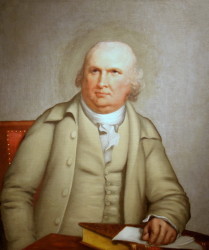
Oil painting of Robert Morris by Robert Pine (c. 1785)
–Robert Morris (Pennsylvania) (No relation to Lewis Morris above.) One of the wealthiest individuals in America, he was a 42 year old Philadelphia merchant and speculator when he signed. Born in Liverpool, he had come to America and made a fortune as a merchant, becoming the “Financier of the Revolution.” Accused of profiteering during the war, he was attacked in the Philadelphia home of fellow signer James Wilson. A delegate to the Constitutional Convention in 1787, he declined to serve as Washington’s secretary of Treasury, recommending Alexander Hamilton instead. He later became a Senator. But he lost his fortune through land speculation and was bankrupted and put in debtor’s prison. He died in poverty and relative obscurity in 1806, aged 72. YES
–John Morton (Pennsylvania) A farm boy turned surveyor, he was 52 at the time of the signing. He has two key distinctions: his vote pushed Pennsylvania into the pro-independence camp and then he was first signer to die. He fell ill in 1777 and died at about age 52, leaving his farm and enslaved people to his wife and children who had to flee from a British attack. YES
June 25, 2018
Whatever Became of 56 Signers? (6th in a series)
…We mutually pledge to each other our Lives, our Fortunes , and our Sacred Honor.

The Grand Flag of the Union, first raised in 1775 and by George Washington in early 1776 in Boston. The Stars and Stripes did not become the “American flag” until June 14, 1777. (Author photo © Kenneth C. Davis)
(Sixth in a series. Note: The Yes after a named means the Signer enslaved people; No means he did not. The first post is here.)
Wealthy planters, merchants and moderates
-Richard Henry Lee (Virginia) A 41 year old planter from a prominent Virginia family –his younger brother Francis Lightfoot (See previous post) was also there– Lee deserves more acclaim than he usually gets. A “great orator,” said John Adams, Lee introduced the resolution for independence. Curiously he left Congress and didn’t vote for the resolution or the Declaration, which he signed later in the summer of 1776. He was one of the few signers to actually serve with a Virginia militia unit. He remained in poetics after the war, becoming a vocal opponent of the Constitution but an advocate for the Bill of Rights. He was elected to the U.S. Senate but resigned in ill health and died at age 62 in 1794. YES
–Francis Lewis (New York) A native of Wales, he was a 63 year old merchant at the time of the signing, a key supporter of George Washington, but was instructed not to vote for the Declaration by New York. He then signed in August. During the war, his wife was imprisoned by the British and died shortly after her release, leaving Lewis grief-stricken. He died in 1802 at age 89, was buried in an unmarked grave at Manhattan’s Trinity Church, and now, curious New Yorkers will know why there is a Francis Lewis Boulevard in Queens. YES
–Philip Livingston (New York) The 60-year-old member of one of New York’s wealthiest families, he was a merchant who favored the patriot cause but was, like many New Yorkers, more moderate about declaring independence and was absent when the entire delegation abstained from the vote. But he signed in August. (Robert Livingston, a cousin and member of the Declaration draft committee, was also absent from the vote and never signed the Declaration). The British occupied his Brooklyn home after the fall of New York and used it as a hospital. Although he sold some of his property to support the war effort, his family continued to amass large land holdings in upstate New York. In poor health, he died at age 62 in 1778, when Congress was forced to evacuate Philadelphia and moved to York, Pa. YES
–Thomas Lynch, Jr. (South Carolina) At 27, the second youngest signer (after Edward Rutledge also of South Carolina), he was lawyer and son of a delegate. When his father, a wealthy planter, suffered a stroke, the younger Lynch was sent to Congress. (His father was unable to vote or sign.) Both left for home in poor health and the elder Lynch died en route. Lynch Jr. and his wife later sailed for France in the hope of regaining his health but both died at sea in 1779. YES
June 24, 2018
Don’t Know Much About the 14th Amendment
(The original post of this piece is from July 2010 and was revised in 2015, again in July 2017 and now on June 24, 2018)
“Due Process” and “Equal Protection” for all…
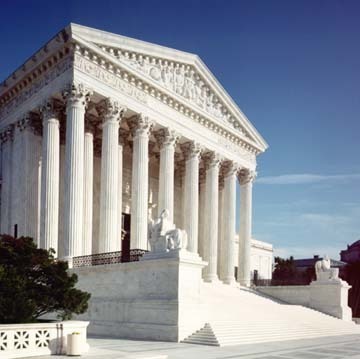
Image Source: Supreme Court of the United States
It seems like a good time to revisit the 14th Amendment in light of the President’s call to deprive immigrants who illegally cross the border of due process rights.
In 1982, the Supreme Court ruled:
“Aliens, even aliens whose presence in this country is unlawful, have long been recognized as ‘persons’ guaranteed due process of law by the Fifth and Fourteenth Amendments.”
Source: Legal Information Institute, Cornell University Plyer v Doe
As another commentator put it:
In summary, the entire case of illegal aliens being covered by and protected by the Constitution has been settled law for 129 years and rests on one word: ‘person.’ It is the word ‘person’ that connects the dots of ‘due process’ and ‘equal protection’ in the 14th Amendment to the U.S Constitution and it is those five words that make the Constitution of the United States and its 14th amendment the most important political document since the Magna Carta in all world history.
Source: “Yes, Illegal aliens have constitutional rights.” The Hill
THE HISTORY:
On July 9, 1868, the states of Louisiana and South Carolina ratified the 14th Amendment to the U.S. Constitution, providing the necessary three-fourths of the states to adopt this very significant Amendment as part of the law of the land.
One of the “Reconstruction Amendments” ratified in the wake of the Civil War, it had far-reaching consequences in American history, touching on many aspects of public and private life in America — from the schoolroom to the bedroom. And it still does.
The first two sections of the Amendment read as follows.
AMENDMENT XIV Passed by Congress June 13, 1866. Ratified July 9, 1868. Section 1. All persons born or naturalized in the United States, and subject to the jurisdiction thereof, are citizens of the United States and of the State wherein they reside. No State shall make or enforce any law which shall abridge the privileges or immunities of citizens of the United States; nor shall any State deprive any person of life, liberty, or property, without due process of law; nor deny to any person within its jurisdiction the equal protection of the laws.
Section 2. Representatives shall be apportioned among the several States according to their respective numbers, counting the whole number of persons in each State, excluding Indians not taxed. But when the right to vote at any election for the choice of electors for President and Vice-President of the United States, Representatives in Congress, the Executive and Judicial officers of a State, or the members of the Legislature thereof, is denied to any of the male inhabitants of such State, being twenty-one years of age,* and citizens of the United States, or in any way abridged, except for participation in rebellion, or other crime, the basis of representation therein shall be reduced in the proportion which the number of such male citizens shall bear to the whole number of male citizens twenty-one years of age in such State. *Changed by section 1 of the 26th amendment.
Its immediate impact was to give citizenship to “all persons born or naturalized in the United States,” which included formerly enslaved people. Creating national citizenship that was independent of state citizenship, the 14th Amendment reversed the 1857 Dred Scott decision which denied citizenship to the enslaved.
In addition, the 14th Amendment forbids states from denying any person “life, liberty or property, without due process of law” or to “deny to any person within its jurisdiction the equal protection of its laws.”
These clauses, usually referred to as “due process” and “equal protection,” have been involved in some of the most significant decisions in American history. You don’t need to be a Constitutional scholar to understand this Amendment and the profound impact it has had –and continues to have– on every American’s life as well as the rights of non-citizens.
The 14th Amendment has been invoked in such major decisions as Brown v. Board of Education in 1954, which ended segregation of public schools; Roe v. Wade (1973), which disallowed most existing restrictions on abortion; and Loving v. Virginia (1967), which ended race-based restrictions on marriage in America. It also provided the Constitutional authority for many of the most important pieces of civil rights legislation passed in the 1960s. And the 14th Amendment has been central to the same-sex marriage debate. Here is an article from the National Constitution Center on 10 Supreme Court Cases about the 14th Amendment.
And here are other resources on the 14th Amendment from the National Constitution Center’s Interactive Constitution.
Here is a link to more information on the 14th Amendment from the Library of Congress.
Whatever Became of 56 Signers (5th in a series)

Fair Copy of the Draft of the Declaration of Independence (Source New York Public Library)
(This is the fifth in a series. The first post is linked here.)
Slave trader turned early abolitionist. Flag designer. “First President.” And the Author.
-Stephen Hopkins (Rhode Island) Second oldest delegate after Franklin, Hopkins was 69 years old at the signing. A merchant, he had been Rhode Island’s colonial governor but was an outspoken advocate of independence. A partner of the wealthy Brown brothers who were involved in the slave trade –Newport was a key northern slavery port– he enslaved several people. But in 1774, he secured passage of law prohibiting the slave trade in Rhode Island, one of the first anti-slavery laws in the colonies and he began freeing some but not all of the people he enslaved. In ill health, he retired from politics and public life and died in 1785 at age 78. YES, but he had begun began freeing some of them by 1776.
-Francis Hopkinson (New Jersey) Like Franklin and Jefferson, Hopkinson was a man of many talents, a 38 year old attorney and musician at the time of the signing, he was the son of the founder –with Franklin– of the University of Pennsylvania and was among the school’s first graduates. Though long overlooked, he has more recently gotten his due as the designer of the “Stars and Stripes.” The claim is based on Hopkinson submitting a bill for his work on the flag and requesting “a quarter cask of the public wine” in payment. He was already on the Congressional payroll so was refused. While his home was ransacked during the war, he emerged relatively unscathed and later became a Federal judge before his death in 1791 at 53. YES
-Samuel Huntington (Connecticut) An apprenticed barrel-maker who became a successful attorney, he was a 45 year old politician at the time of the signing, having resigned his post as “King’s Attorney.” His true distinction is serving as “President of the United States in Congress Assembled” when the Articles of Confederation were adopted –making him the “First President,” sort of. Others have staked that claim as well. He served in a variety of national and state posts, including being the sitting governor of Connecticut at his death in 1796 at age 64. NO
–Thomas Jefferson (Virginia) 33 year old planter, scientist, writer, lawyer. You know most of the rest. But Jefferson’s wartime service as Virginia’s governor is sometimes overlooked. In 1781,he was governor when the British attacked the state, including forces led by Benedict Arnold. Jefferson fled and was later investigated by the state legislature but no charges were filed. Some of his slaves were taken by the British and were being held in Yorktown during the siege in September-October 1781 and were later returned to Jefferson by George Washington. He died, like John Adams, on the 50th anniversary of the adoption–July 4, 1826. See the Monticello site for more information. YES
–Francis Lightfoot Lee (Virginia) A member of the state’s prominent planter family, he was 41 years old at the signing, the quiet brother of Richard Henry Lee, who offered the first resolution calling for independence in June 1776. After the war, he was a prominent advocate of the new Constitution, unlike his more visible older brother. He left the national scene and died at age 62 in 1797. YES
June 23, 2018
Whatever Became of 56 Signers? (4th in a series)
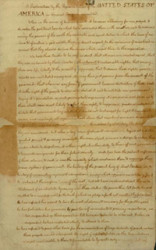
Fair Copy of the Draft of the Declaration of Independence (Source New York Public Library)
…We mutually pledge to each other our Lives, our Fortunes , and our Sacred Honor.
Part 4 in a series that begins here.
Father and grandfather of presidents. A simple farmer. A workaholic. The next five signers, in alphabetical order: (Yes following the entry means slaveholder; No means not a slaveholder.)
-Benjamin Harrison (Virginia) A member of the Virginia aristocracy, he was a well-to-do planter, around 50 at the the signing. Although his famed Berkeley Plantation on the James River was supposedly destroyed during the Revolution, it clearly survived. So did Harrison, who went on to serve three terms as governor of Virginia before his death in 1791 at age 65. Besides his role in the July 2 and 4 votes in Philadelphia, he is mostly distinctive as the father of 9th president William Henry Harrison and grandfather of namesake Benjamin Harrison, the 23rd president. YES
-John Hart (New Jersey) Described as a well-meaning “Jersey” farmer with little education, Hart was a 65 year old planter at the time of the signing, and devoted to the patriot cause. Although supposedly hounded by the British during the war, he was later able to entertain General Washington and allow 12,000 troops to camp in his fields in 1778. He died of kidney stones in 1779, aged 68. YES
–Joseph Hewes (North Carolina) Born in New Jersey, he moved to North Carolina and was a 46 year old Quaker merchant at the signing. At first a reluctant patriot, he broke with the Quakers over the possibility of a violent rebellion and was considered a key influence in Congress by John Adams. His shipping experience was significant enough for him to be described as the first “secretary of the Navy,” responsible for getting his friend John Paul Jones a commission. Working relentlessly for the Congress, Hewes fell sick and died in 1779 at age 49 and was deeply mourned by his Congressional colleagues. YES
-Thomas Heyward, Jr. (South Carolina) Son of a wealthy planter, he was a 30 year old lawyer at the signing. Heyward counts as one of the few signers actually captured by the British, who then took his enslaved people, apparently shipping them to bondage in the West Indies. Initially paroled (released under an agreement), he was later taken aboard a prison ship and then held in St. Augustine, Florida under a form of house arrest until released in a prisoner exchange. While a hostage, he is credited with writing verses to a song called “God Save the Thirteen States.” He dabbled in politics after the war, but focused on rebuilding his family plantation where he died at 63 in 1809. YES
-William Hooper (North Carolina) Born in Boston, he was a 34 year old attorney who had moved South at the signing. He missed the key July vote but returned to sign the Declaration in August. Hooper was one of the signers who suffered losses during the war when the British invaders evacuating the Wilmington, North Carolina area and destroyed his home. He later pressed for ratification of the Constitution but lacked popularity in his adopted state and, suffering from a variety of illnesses, including malaria, died in 1790 at age 48. YES
[image error]
Don’t Know Much About® the American Presidents (Hyperion Paperback-April 15, 2014)

America’s Hidden History, includes tales of “Forgotten Founders”
[image error]
Don’t Know Much About® History: Anniversary Edition (Harper Perennial and Random House Audio)
June 22, 2018
Whatever Became Of…56 Signers? (3d in series)

Fair Copy of the Draft of the Declaration of Independence (Source New York Public Library)
[Post revised June 22, 2018]
Part 3 in a series of posts about the fates of the signers of the Declaration of Independence. A printer, a politician with a notable name, a duelist, a Connecticut Yankee, and the most famous signature in U.S. history.
A Yes after their names means they enslaved people; No means they did not.
-Benjamin Franklin (Pennsylvania) America’s most famous man in 1776, Franklin was 70 years old at the time of the signing. Printer, publisher, writer, scientist, diplomat, philosopher –he was the embodiment of the Enlightenment ideal. A member of the draft committee that produced the Declaration, Franklin was a central figure in the independence vote and then helped the war effort by winning crucial French support for the America cause. But he lost no Fortune, reportedly tripling his wealth during the conflict. Franklin returned to the scene of the Declaration’s passage in 1787 to help draft the Constitution.. When he died at age 84 in 1790, his funeral was attended by a crowd equal to Philadelphia’s population at the time. Read more on Franklin at this National Park Service site. YES
–Elbridge Gerry (Massachusetts) A 32 year old merchant from Marblehead, Gerry (pronounced with a hard G like Gary) is much more famous for later dividing Massachusetts into oddly-shaped voting districts as the state’s governor. A cartoonist compared the districts to a salamander and the word “gerry-mandering” was born. Though he voted for independence, Gerry was not present to sign in August, signing later in the fall of 1776, He profited from the war and later joined the Massachusetts delegation to the Constitutional convention in 1787, although he refused to sign the Constitution. He became James Madison’s second vice president in 1813, but died in office in 1814 at age 70. NO
–Button Gwinnett (Georgia) An English-born plantation owner and merchant, he was 41 at the time of the signing. And didn’t last much longer. A political argument with a Georgia general led to a duel in which Gwinnett was mortally wounded. He died in 1777 at age 42, the second of the signers to die. (John Morton of Pennsylvania was first.) YES
–Lyman Hall (Georgia) A Connecticut Yankee physician transplanted to Georgia plantation owner, Hall was 52 years old at the signing. A vocal patriot when Georgia was far more hesitant about independence, he first came to Philadelphia as a nonvoting delegate. Hall’s plantation was destroyed during the war when the British made their punishing attacks on the South. He later served as Georgia’s governor, dying at age 66 in 1790. YES
–John Hancock (Massachusetts) Born into a poor parson’s family in Lexington (National Parks Service site) , Hancock was sent to live with a wealthy uncle when his father died. He inherited his uncle’s shipping business and was one of America’s wealthiest men by the time he was thirty. A patriot leader in Boston, it was Hancock and Samuel Adams who the British sought to capture on that April 1775 night when the war began. President of the Continental Congress when independence was declared, he was 39 at the time of the signing. The outsized signature on the document cemented his fame in American lore. After the war, Hancock was governor of Massachusetts at the time of his death in 1793 at age 56. YES




